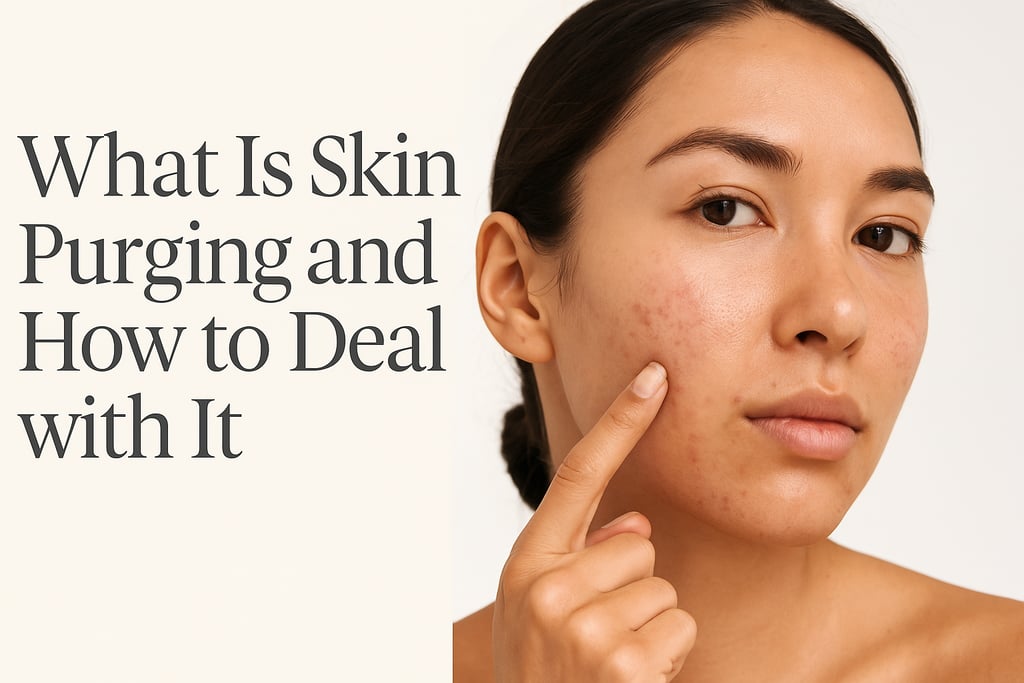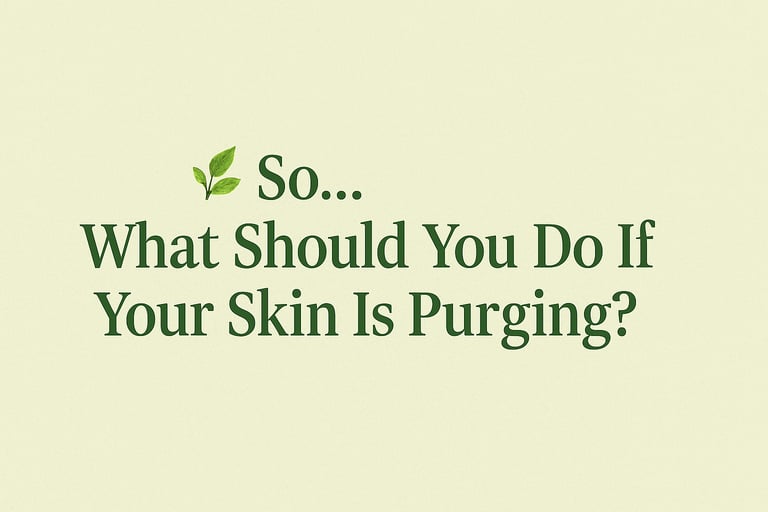What is Skin Purging (and How to Deal with It Without Panic)
You’ve just added a shiny new serum to your routine — maybe it’s packed with retinol, AHA, or niacinamide. You’re excited. Your skin? Not so much. A few days later, you’re staring at fresh breakouts and wondering: “Is this supposed to happen?” Before you toss the product in frustration, let’s talk about something many skincare lovers experience (but few understand at first): skin purging.
SKINCARE & CLEAN BEAUTYWHAT WE RECOMMEND
6/5/20253 min read


What is Skin Purging (and How to Deal with It Without Panic)
You’ve just added a shiny new serum to your routine — maybe it’s packed with retinol, AHA, or niacinamide. You’re excited. Your skin? Not so much. A few days later, you’re staring at fresh breakouts and wondering: “Is this supposed to happen?”
Before you toss the product in frustration, let’s talk about something many skincare lovers experience (but few understand at first): skin purging.
💥 What Exactly Is Skin Purging?
Skin purging is a temporary reaction that happens when certain active ingredients — especially ones that increase cell turnover — bring everything to the surface faster than usual. That means clogged pores, bacteria, and trapped oils might suddenly erupt as breakouts. Sounds terrifying? Don’t worry — it’s a sign the product is working.
🧪 Ingredients commonly associated with purging:
Retinoids (retinol, tretinoin)
AHAs (like glycolic acid)
BHAs (like salicylic acid)
Vitamin C
Exfoliating enzymes
These ingredients speed up how quickly your skin sheds dead cells, which can initially cause congestion to rise — before your skin clears and glows.


🤔 Skin Purging vs. Breakouts: How to Tell the Difference
Let’s get one thing clear: not all breakouts are purging. Sometimes your skin is reacting negatively, and knowing the difference can save your skin (and your patience).
Here’s how to tell them apart:
Timing: Skin purging usually begins within 2 to 7 days of starting a new product, especially one with active ingredients. In contrast, breakouts or reactions can occur at any time — even after weeks of use.
Location: Purging tends to happen in areas where you normally break out. If blemishes are showing up in spots where you rarely have acne, that’s a red flag it may be a reaction.
Duration: A purge typically clears within 2 to 6 weeks. If things are only getting worse, or the breakouts linger well past that point, it’s probably not purging.
Texture: Purging often appears as small, consistent bumps. Reactions, on the other hand, can show up as inflamed, painful, or cystic acne that feels more intense and out of control.
Other signs: Mild dryness or flaking is common during a purge. But if you’re experiencing burning, itching, swelling, or redness, your skin may be having a negative reaction — not adjusting.
👉 Bottom line: If your skin is flaring in new ways — like stinging or rash-like bumps — it's probably not a purge. It's your skin saying, “nope.”
🌿 So… What Should You Do If Your Skin Is Purging?
First: don’t panic. Skin purging means your skin is adjusting — here’s how to support it:
1. Ease into it
Instead of using that exfoliant or retinol every night, start 2–3 times a week. Let your skin build tolerance.
2. Hydrate like your glow depends on it (because it does)
Focus on barrier-loving ingredients:
Hyaluronic acid to lock in moisture
Centella asiatica or panthenol to calm irritation
Ceramides to reinforce your skin barrier
3. Skip harsh actives temporarily
Avoid adding more exfoliants or actives while purging. Think of your skin like it’s at the gym — it’s sore, and it needs rest days.
4. Wear sunscreen (non-negotiable)
Sun protection helps prevent irritation from getting worse and keeps healing on track.
🧴 Product Recommendations to Get Through a Skin Purge Gently
✅ haruharu wonder Centella 5% Niacinamide Radiance Gel Cream
This lightweight gel cream soothes, hydrates, and brightens dull skin — perfect during a purge. Formulated with 5% Niacinamide and Centella Asiatica extract, it calms inflammation and supports skin barrier recovery.
✔️ Fragrance-free
✔️ Non-sticky texture
✔️ Great for oily and sensitive skin types
✅ COSRX Low pH Good Morning Gel Cleanser
A gentle, skin-balancing cleanser that keeps your pH in check — ideal during purging when your skin barrier needs calm and consistency. It uses tea tree oil and natural BHA to cleanse without stripping.
✔️ Low pH (around 5.0–6.0) = barrier-safe
✔️ Mild but effective on clogged pores
✔️ A cult favorite for oily, acne-prone, or sensitive skin
✅ MISSHA Premium Cica Aloe Soothing Gel 300ml – $7
This cooling gel combines aloe vera and centella asiatica to relieve redness, dryness, and irritation — especially useful when your skin feels hot, tight, or flaky during purging.
✔️ Multipurpose: face & body
✔️ Lightweight, refreshing
✔️ Great value for the size
✨ [Fast/Free Shipping across US & Canada from PinknBlossom — Free samples in every order!]
🚨 When to Stop Using the Product
Even though skin purging is normal, it shouldn’t last forever. Stop and reassess if:
Breakouts worsen after 6 weeks
You develop cystic acne or deep painful bumps
You feel burning, stinging, or rash-like irritation
Listen to your skin. If it’s not improving, it’s okay to take a break or consult a dermatologist.
🌈 Final Thoughts
Skin purging is a weird, uncomfortable rite of passage — but also a sign of transformation. It’s your skin cleaning house, shedding layers, and prepping for the glow-up. The key is knowing the difference between a purge and a full-on product fail.
So breathe easy, stay consistent, and treat your skin like your favorite plant — gently, lovingly, and with patience.
Want more tips and product guides like this?
🛍 Browse our handpicked skincare at Dealaha.com
#NoToxinsJustGlow
Quality You Can Trust
Discover handpicked, high-quality products that support a healthier, more intentional lifestyle.
Contact
Stay in the Loop
© 2025 Dealaha™ All rights reserved.
